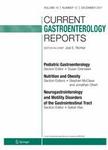版权所有:内蒙古大学图书馆 技术提供:维普资讯• 智图
内蒙古自治区呼和浩特市赛罕区大学西街235号 邮编: 010021

作者机构:Cancer Prevention and Control Program Moores Cancer Center University of California San Diego La Jolla CA United States Department of Internal Medicine University of Texas Southwestern Medical Center Dallas TX United States Department of Family and Preventive Medicine University of California San Diego CA United States Institute for Behavioral and Community Health Graduate School of Public Health San Diego State University San Diego CA United States Department of Family Medicine and Community Health Perelman School of Medicine Philadelphia PA United States Division of Gastroenterology Department of Medicine Howard University College of Medicine Washington DC United States Veterans Affairs San Diego Healthcare System San Diego CA United States Division of Gastroenterology Department of Internal Medicine Moores Cancer Center University of California La Jolla CA United States
出 版 物:《Current Gastroenterology Reports》 (Curr. Gastroenterol. Rep.)
年 卷 期:2015年第17卷第6期
页 面:22-22页
学科分类:1002[医学-临床医学] 100201[医学-内科学(含:心血管病、血液病、呼吸系病、消化系病、内分泌与代谢病、肾病、风湿病、传染病)] 10[医学]
基 金:National Cancer Institute, NCI, (U01CA114657-05, U54CA153511) Office of Research and Development, ORD
主 题:cancer disparities Colorectal cancer screening Hepatocellular carcinoma screening
摘 要:Colorectal cancer (CRC) and hepatocellular carcinoma (HCC) are common causes of cancer incidence and mortality in the USA, particularly among underserved populations such as racial/ethnic minorities, the under-/uninsured, and individuals with low socioeconomic status. Although screening can reduce cancer-related mortality, participation is suboptimal among underserved populations, likely serving as the largest contributor to observed inequities in HCC and CRC outcomes among US populations. In this narrative review, we highlight inequities across populations in the USA with respect to incidence and mortality for CRC and HCC and highlight potential causes, with a focus on screening rates. In addition, drawing from the recent literature, we highlight promising strategies for increasing screening for HCC and CRC and propose future research and policy solutions to optimize screening rates. With focused implementation of screening strategies and novel research, the burden of HCC and CRC can be reduced among underserved populations. © 2015, Springer Science+Business Media New York (outside the USA).